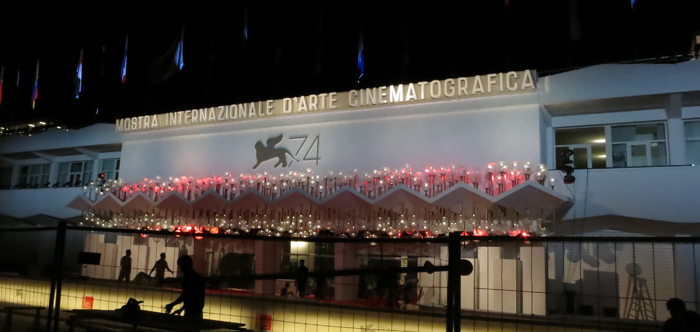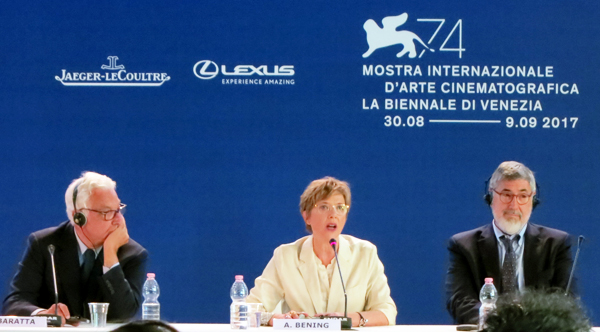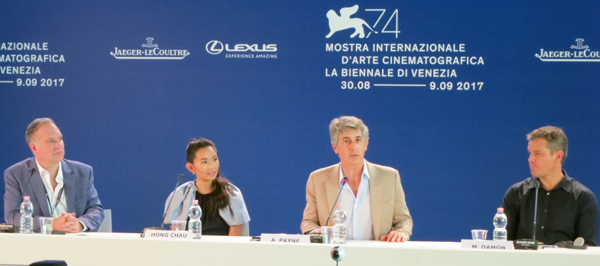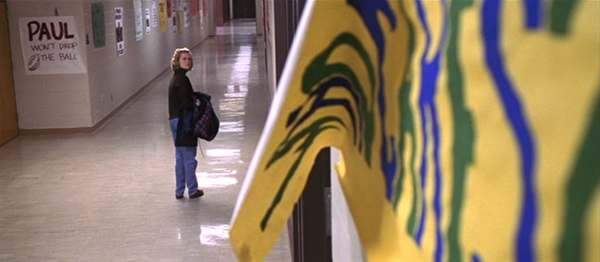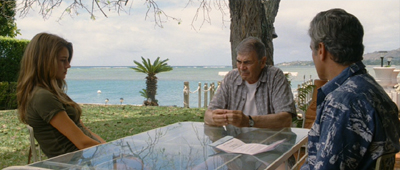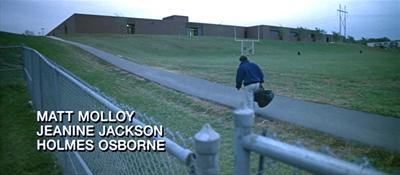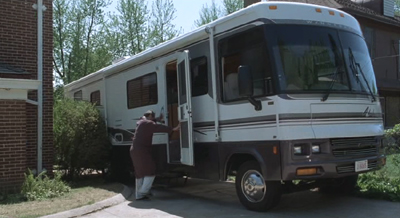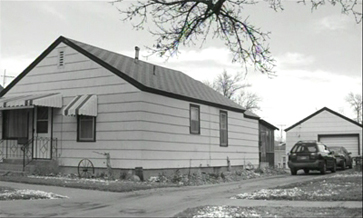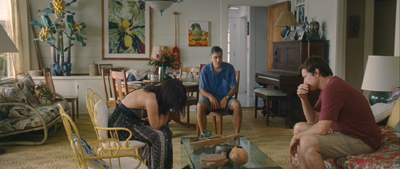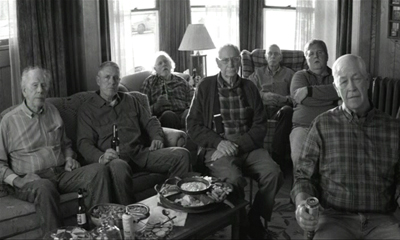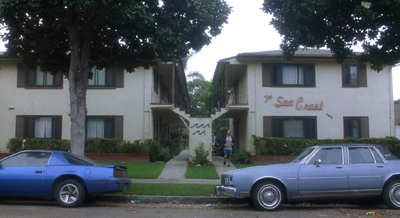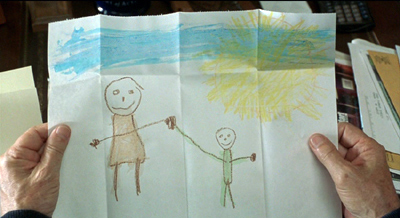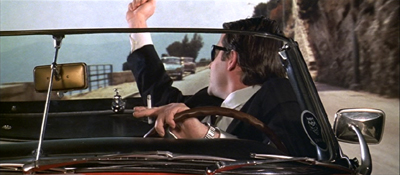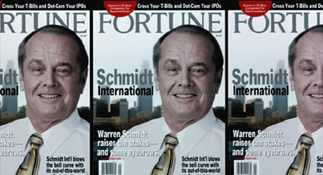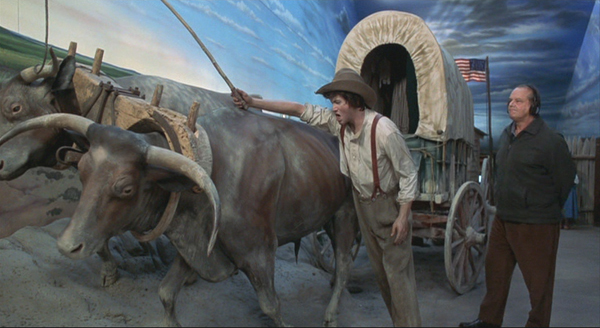Archive for the 'Directors: Payne' Category
Venice 2017: Early days
DB here:
After the triumph of Rosita (more on that to come), the first full day of the Biennale launched with several press screenings and press conferences. The opening conference featured Festival President Paolo Baratta (below), Director Alberto Barbera, and jury heads including Annette Bening (below), Benoît Jacquot, and John Landis (below).
During that session, two subjects recurred: Netflix and Virtual Reality. Some Netflix films are playing out of competition: Our Souls at Night, with Robert Redford and Jane Fonda (who will get honorary Golden Lion awards); and Netflix’s first Italian production, Suburra. In addition, the Mostra will show all the episodes of Errol Morris’s Netflix series Wormwood. Barbera remarked that festivals must follow where auteurs lead. Now that so many filmmakers are directing telefilms and series “with the same attitude” they employ in theatrical features, festival progamming must take notice.
 Similarly with VR. Baratta pointed out that this medium is now being used by artists, and Venice has a historical and aesthetic obligation to keep up with moving-image explorations. Barbera added that for him VR was not the future of movies; it’s a new medium that will exist alongside them. Just as film didn’t kill theatre and television didn’t kill film, VR is likely to flourish on its own. It will likely have its dedicated venues, such as MK2’s VR theatre in Paris and similar spots in Amsterdam.
Similarly with VR. Baratta pointed out that this medium is now being used by artists, and Venice has a historical and aesthetic obligation to keep up with moving-image explorations. Barbera added that for him VR was not the future of movies; it’s a new medium that will exist alongside them. Just as film didn’t kill theatre and television didn’t kill film, VR is likely to flourish on its own. It will likely have its dedicated venues, such as MK2’s VR theatre in Paris and similar spots in Amsterdam.
John Landis admitted that he was intrigued by VR and wanted to learn how to use it. Can it tell a full-length story? (Most VR pieces are short and situation-bound.) Can it focus the viewer’s attention—a key component of traditional visual narrative? Landis noticed that his experiences of VR gave the viewer great freedom of when and where to look. Could storytelling harness that freedom? It was good to see a filmmaker pondering these basic issues.
We saw the first screening of Alexander Payne’s Downsizing, a sharp and heartfelt satire on consumerism and ecology. Matt Damon and Kristen Wiig play a couple who decide to take advantage of a new technology that shrinks humans to 5-inch heights, and thus allows them to live more cheaply and reduce the strain on the planet.
The situation takes several unpredictable turns and in the face of impending disaster veers into a Capraesque optimism. Yet there’s a somberness here too, perhaps most akin to that in About Schmidt. Alexander mentioned Chekhov as an influence, and he admired the writer for realizing that emotional effects stand out against “a cold background.” The clinical scientific milieu of the downsizing operation and the arid cheerfulness of Leisureland, a sort of micro-EPCOT, provide that backdrop for the problems facing tiny Matt Damon.
In the press conference, Damon called Alexander’s direction meticulous and “sure-handed.” That shows in the film: No bouncy-camera grab-and-go, but precisely staged scenes. One sequence, that showing the medical mechanics of the downsizing process, is shot for shot as cogent and engaging a stretch of cinematic storytelling as I’ve seen in a long while. There’s also a good gag when Damon wakes up from the surgery and immediately…well, I can’t spoil it. Below, here are Jim Taylor, co-screenwriter; actor Hong Chau, who plays a Vietnames dissident; Payne; and Damon.
Our old friend Mark Johnson produced the film. It was encouraging to see the huge press turnout and the excellent reviews (Variety Hollywood Reporter, The Wrap) that Downsizing got. It goes immediately to Toronto.
Thanks to Peter Cowie, Alberto Barbera, Michela Lazzarin, and all of their colleagues for inviting and assisting us.
We have a blog entry devoted to Alexander Payne here, where he mentions his and Jim’s long-germinating plans for Downsizing. Kristin compares his work to Chekhov there too.
Alexander Payne’s vividly shot reality
Election.
Kristin here:
Both David and I missed almost all of this year’s Wisconsin Film Festival. I was in Egypt wearing my archaeologist’s hat and working on ancient statuary, and David was attending the Hong Kong International Film Festival. (See his reports, here and here.) Luckily we made it back just in time for Alexander Payne’s spring visit to Madison.
 I first met Alexander at last year’s Il Cinema Ritrovato festival in Bologna. He already knew who I was from having read Film Art: An Introduction, and we started chatting. We were in a small crowd outside the Arlecchino cinema, where a screening was running late. I asked Alexander what he had seen at the festival that he liked. He said he had come from a screening of Sjöström’s Ingeborg Holm and thought it was a masterpiece. Right away I knew that this man has impeccable taste in movies. (Alexander further proved this during his recent visit, saying that his favorite three films of Il Cinema Ritrovato were Ingeborg Holm, Naruse’s Wife, Be Like a Rose, and Rossellini’s Il Generale Della Rovere.)
I first met Alexander at last year’s Il Cinema Ritrovato festival in Bologna. He already knew who I was from having read Film Art: An Introduction, and we started chatting. We were in a small crowd outside the Arlecchino cinema, where a screening was running late. I asked Alexander what he had seen at the festival that he liked. He said he had come from a screening of Sjöström’s Ingeborg Holm and thought it was a masterpiece. Right away I knew that this man has impeccable taste in movies. (Alexander further proved this during his recent visit, saying that his favorite three films of Il Cinema Ritrovato were Ingeborg Holm, Naruse’s Wife, Be Like a Rose, and Rossellini’s Il Generale Della Rovere.)
Alexander is a friend of Jim Healy, head programmer for the University of Wisconsin-Madison’s Cinematheque screening series and of the Wisconsin Film Festival. Jim seems to know half the people in the film industry as well as in the festival and archival spheres; he has already brought Tim Hunter and Joe Dante to campus. I knew he hoped to bring Alexander as well, so I put in a pitch for the idea, mentioning how enthusiastic the film students and buffs are in Madison and how he would enjoy speaking with audiences here, who would ask interesting questions. Luckily for me that turned out to be true, a mere nine months later. (Left, Alexander and Jim in a local Madison burger joint.)
Alexander Payne, cinephile
Alexander participated in a number of events here in Madison, some associated with the Wisconsin Film Festival and others with the Department of Communication Arts. The first was a session of our divisional film colloquium, which 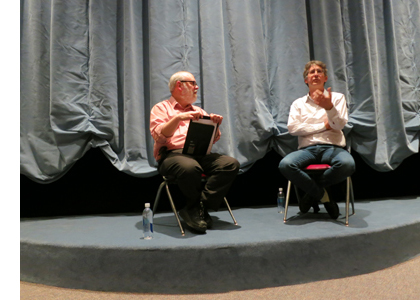 began with David and Alexander in discussion onstage (right) and then opened for questions from the faculty and graduate students.
began with David and Alexander in discussion onstage (right) and then opened for questions from the faculty and graduate students.
The conversation began with Alexander recalling how he fell in love with movies, which he reckons happened at about the age of four. He watched mainly older movies. In those days there were rival houses in his hometown of Omaha. His father owned a restaurant in Omaha, and for some reason one of his suppliers, Kraft, gave him a regular-8mm movie projector. Alexander started collecting films, buying prints initially from the now defunct Castle company and later from the still functioning Blackhawk Films.
These included all twelve Chaplin shorts made at Mutual. Many years later, Alexander supported the restoration of the last of that set, The Adventurer. That’s what had brought him to Bologna. He introduced the film, which was shone as one of several new restorations in the Essanay/Mutual Project of the Fondazione Cineteca Di Bologna and Lobster Films. (See here for information on the project and program notes for this year’s screenings.) It was screened at one of the 10 pm programs in the Piazza Maggiore, with Sjöström’s The Outlaw and His Wife, also newly restored.
Jumping back to Alexander’s progress as a cinephile, he became an undergraduate at Stanford, studying history and Spanish. From there he moved on to UCLA for an education in filmmaking, and “thought it was heaven.” He loved it so much that he delayed starting his filmmaking career and stayed on to see more film’s in the famous Melnitz Hall screening room. In those days, 35mm prints were regularly shown, including nitrate originals. (Probably around ten years ago I saw a nitrate print of Trouble in Paradise there, being shown for a class. It definitely was heaven.)
There he recalls seeing such things as an Antonioni retrospective and Double Indemnity. When he was in his 30s, he fell in love with Italian and Japanese cinema. Now that he has reached his 50s, he has broadened his interests to study the films of Hollywood directors like Michael Curtiz and Raoul Walsh. He admires the conciseness of their films: “Film,” he says, “is a constant search for economy.”
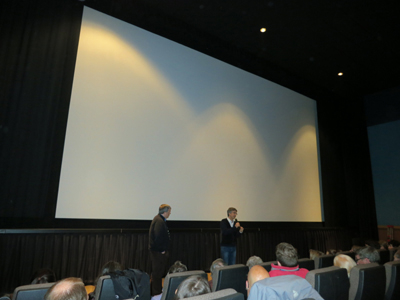 Alexander’s love of Italian films was in evidence at one of the final events of the Wisconsin Film Festival. He had been asked to choose an older film that he could introduce and answer questions about afterward. His choice was Il Sorpasso (1961, Dino Risi). The auditorium at our local arthouse multiplex, Sundance 608, was packed with a very enthusiastic audience indeed. (Left, Alexander after being introduced by Jim Healey.)
Alexander’s love of Italian films was in evidence at one of the final events of the Wisconsin Film Festival. He had been asked to choose an older film that he could introduce and answer questions about afterward. His choice was Il Sorpasso (1961, Dino Risi). The auditorium at our local arthouse multiplex, Sundance 608, was packed with a very enthusiastic audience indeed. (Left, Alexander after being introduced by Jim Healey.)
The next evening, Alexander did the same for a screening of Nebraska at Union South. Again a full house, and again an audience eager to ask questions.
In between such events, we shared some restaurant meals. Alexander, Jim, and David sounded like some contrapuntal version of the Internet Movie Database, tossing titles, directors, and other film credits back and forth.
During these conversations, and indeed every other conversation we had with him, Alexander would pull out a small pocket notebook (though paper napkins sometimes substituted) and write down any intriguing-sounding title of a film he hadn’t seen. Not only a cinephile, but a systematic one.
Not surprisingly, during the colloquium discussion the issue of Nebraska being shot in black-and-white came up. David mentioned that Bong Joon-ho had said to him (while they were both jury members at this year’s Hong Kong Film Festival) that every director wants to make a black-and-white movie.
Given his love for older films, Alexander considers that “Our great film heritage is black and white.” Inevitably, during the press junkets for Nebraska, reporters asked him why he made the film in black and white. What he wants to know is, “Why is that the first question?”
Alexander agrees with Bong: “I don’t think a director is really a director until he or she has made a film in black and white.” He approached Paramount with the idea of making Nebraska as a black-and-white film and argued that it would be viable because it had a low budget of $12 million. He adds that directors have faced the same arguments against black and white since the 1970s, as when Peter Bogdanovich was making Paper Moon. The TV contracts specify color.
Alexander wanted to shoot Nebraska on film, but the only black-and-white stock available had an ASA of 200, which would not be effective for night shooting. He had to shoot digitally and add contrast and grain afterward to get a film look.
He definitely regrets the loss of film, which he considers superior to video: “I think flicker will always be superior to glow.”
Alexander says he is a big fan of the 1970s because he was a teenager at the time. He thinks that a lot of films made then and released into regular theaters could not be shown today outside arthouses. Films then were judged by their closeness to reality, not their distance from it. For him, “There’s just a consistently fine product being turned out between The Graduate [1967] and Raging Bull [1980].”
It was the period when a generation of filmmakers came to prominence, filmmakers who today are the grand old men of Hollywood. David pointed out that Alexander has often been mentioned as part of a later generation that included such directors as Quentin Tarantino and Paul Thomas Anderson. Alexander agreed that there was the “Class of 1999” that included films like Election and Fight Club (putting David Fincher in the same group). He says of these directors, “We’re friendly enough.” But he envies the Spielberg, Coppola, Scorsese, Lucas generation because they were able to help each other out in filmmaking. His generation doesn’t socialize much, though he said he had seen Soderbergh recently.
The Milos Forman of Nebraska
For anyone who had been unaware that Payne comes from the vast territory in the middle of the USA that encompasses the Midwest and Great Plains and is generally known as Flyover Territory, his latest film makes that point clear. He was born and raised in Omaha, and still lives part of the year there. As he explained in the colloquium discussion, “I’m one of those people in the arts who are interested in exploring where they’re from.” This is not to say that all of his films are set in Nebraska, but four of the six features take place there, explicitly or implicitly.
Citizen Ruth has no identifiable setting, as far as I could tell, though its milieu is clearly centered in small-town life in the country’s midsection. It was shot in Council Bluffs, Iowa, and Omaha. Election doesn’t stress the fact, but close shots of newspaper stories reveal that its story is set in Omaha. Warren Schmidt lives there as well, and his road trip to his daughter’s wedding takes him to Denver and brings him back home. Payne’s next two films were set in quite different parts of America: Sideways in San Diego and California wine country and The Descendants in Hawaii. Nebraska chronicled David Grant’s journey with his father Woody from Billings, Montana, to Lincoln, taking in several rural and small-town locations along the way.
Each story mixes humor and pathos, including both satirical swipes at locals and great affection for them. It’s hard to pin down their genres. (The Internet Movie Database classifies About Schmidt as a comedy/drama and Nebraska as an adventure/drama.) In the colloquium, Payne remarked of Nebraska, “I call it my own Czech Republic. I get to make Milos Forman films about it.”
It is a cliché to say that the settings in which a film’s action takes place become a character in the drama, but Payne’s films really do manage to keep us aware of the surroundings to surprising extent. Payne says that when he discusses a film with his cinematographer and production designer, he says he wants “Vividly shot reality.”
Vivid can simply mean beautiful, and there are many such landscapes, as in The Descendants:
But it need not mean that. The choice of framing in the opening scene of Election, with the fence in the foreground and the school crouched ominously high on the hill tend to make it look like a prison:
Emphasis on locales can be created by something as simple as a slight wide-angle lens that adds dimension to a house, making it more prominent within its surroundings, as in The Descendants, About Schmidt, and Nebraska, where the vegetation framing the building, ranging from lush to ordinary to sparse, help define the homes of the main characters:
To achieve the desired vividness, Payne often chooses to use real interiors, even if that limits the types of set-ups he can make. The result can be busy but spacious and attractive, as in The Descendants:
Or the constraint can turn to an advantage, as in the confined arrangement filmed from a television’s point of view for the “That Impala you used to have …” long take in Nebraska:
This latter scene exemplifies something else that Payne considers crucial for achieving realism: the addition of extras and small roles, often played by non-actors found in the area where location filming is occurring.
Alexander sometimes uses symmetry to make a fairly ordinary locale more vivid, as in these planimetric shots from Sideways and About Schmidt:
Vivid shots can make a thematic point, as in The Descendants. Shots of Matt and his daughters being driven through their unspoiled ancestral land lead to a view of them being driven up to the sort of elegant resort that could be built on that land if they sell it. The second shot is pretty and well composed, but the juxtaposition with the series of shots that preceded it should make us sense it as slightly menacing as well:
I’ve stuck mainly to long shots here, since that’s where the vivid realism tends to come. There are many unusually close views of characters as well, which contrast with these long shots. There we tend to get the psychological side of these films, which are basically character studies. This contrast may be what gives Alexander’s films a sense both of place and of intense concentration on characters.
Alexander Payne, storyteller
We all know that Oscar wins and nominations don’t always go to the actual best films of the year. But they do reflect something about the reputation of a filmmaker within the industry. Alexander has had two films nominated for best picture: The Descendants and Nebraska. That these nominations are not simply the result of the Academy of Motion Picture Arts and Science’s switch to a ten-nominee best-picture category is reflected in the fact that he has been nominated for best director three times: Sideways, The Descendants, and Nebraska. He and his co-writers have also been nominated three times for best adapted screenplay: Election, Sideways, and The Descendants. The only film which Payne did not co-write, Nebraska, received an nomination for best original screenplay, by Bob Nelson. All these nominations produced two wins, for the screenplays of Sideways and The Descendants. Clearly Alexander is recognized in Hollywood as a fine storyteller.
Apart from Citizen Ruth and Nebraska, all of Alexander’s films are based on novels. In the colloquium discussion with David, he said he prefers adapting novels, which are ready-made stories. He doesn’t have the original ideas, but he can deal with them almost like a documentarian filming an imagined reality. Most of the novels have been based on the authors’ own experiences, and most of them are regional. “You can find a world and have a dialogue with it.”
His sources are generally not well-known novels. None of the Jane Austen-style prestigious literary property here. Neither Election nor Sideways had been published at the point where he decided to adapt them. The Descendants was not a well-known book. As his first project out of film school, Alexander and Jim Taylor, who would collaborate on several scripts, wrote an original one about a retired man in Omaha. When no one in Hollywood was interested, they went on and made Citizen Ruth and Election. Once Election became a critical, if not a commercial, success, they were able to move on to a more ambitious project. In the late 1990s, Louis Begley’s novel, About Schmidt, was suggested to them as a possible vehicle for Jack Nicholson. They derived some elements from it, combining them with their earlier script. It was, by the way, Alexander’s most expensive film at $32 million, half of which went for Jack Nicholson’s fee.
[Thanks to Jim Healey for clarifying About Schmidt‘s origins; this paragraph has been re-written to incorporate the information he provided.]
Clearly he values the tight unity and narrative economy that are characteristic of the studio age of Hollywood filmmaking: “You want your screenplay as streamlined as possible.” That doesn’t mean following a formula, however. He considers that the screenplay manuals that have been so influential, like those of Syd Field and Robert McKee, “destructive.” He dislikes their blanket generalizations. David pointed out that Matt’s voiceover narration in The Descendants is used to provide exposition, but then tapers off at about the midway point. Alexander responds that manuals claims that voiceover should not be used, but that if it is, it should either be used throughout or only at the beginning and end. These strictures he considers absurd. (Interestingly, many classic studios films start with a voiceover that doesn’t return at the end.)
During the colloquium discussion, Alexander remarked, “I like films which are entertaining and charming.” It’s a generalization that could apply to classical studio filmmaking, and it applies to his films as well. These are well-made films made on the whole along classical lines. Their main characters have goals, struggle toward them, meet obstacles, and usually follow an arc at the end of which they have a sudden realization.
Those goals, struggles, and growth also follow a pattern that one could point to in making a case for a thematic consistency in Alexander’s work. These are mostly films where characters struggle against some misfortune or obsessive hatred and eventually come to some sort of reconciliation with their situation.
Warren Schmidt deals with retirements, the death of his wife, and the marriage of his daughter into a family that disgusts him. He concludes that his life has been an utter waste, and yet a sudden realization that a casual act of kindness has made a difference to another person (a six-year-old orphan in Africa whom he has “adopted” through a charity) rescues him from his despair.
In Sideways, Miles cannot accept that his ex-wife has left him and is about to remarry, and he also hopes to find a publisher for his unwieldy, long novel. Only after he accepts both the failure of his marriage and the impossibility of publication can he move on to a possible new romance. In The Descendants, Matt overcomes his rage over his comatose wife’s infidelity in time to bid her a sincere, grief-filled farewell before she dies. In Nebraska, David Grant struggles to convince his father Woody that his delusions, perhaps brought on by increasing dementia, are absurd, but he finally realizes that humoring the old man is a kinder approach for all concerned.
Election, being an early work, largely avoids this pattern. Jim conceives a hatred for Tracy that he never overcomes. He manages to pull himself together after the failure of his marriage and his firing from his high-school teaching post, finding a new romance and a modest job as a guide in a New York museum. Still, his last glimpse of Tracy as an apparently successful assistant to a major politician is resentful and dismissive, as he continues to view her as he had during her candidacy for student president. Here there is no reconciliation in the main plotline.
The films also tend to follow a well-balanced structure that at least sometimes conforms to the four-part structure I have outlined in Storytelling in the New Hollywood and in this blog entry. Election, for example, has a major turning point that comes halfway through: Tracy notices that one of her posters has begun to peel off the wall (see top), and her struggle to re-attach it leads her to lose control for once and destroy her opponent’s posters. It’s a moment that Jim could legitimately use to disqualify her as a candidate, but his own incompetence and her cleverness and ruthless resistance of his accusations ultimately lead to his failure and her success. The Descendants has a well-balanced four-part structure as well.
There is also a playfulness about these films that fits Alexander’s “entertaining and charming” description of classical films. Both Election and About Schmidt, for example, contain inserts showing the protagonists’ absurd visions of themselves as wildly successful, Jim as a Marcello Mastroianni-like sophisticate and Schmidt as a business tycoon:
What about the future? Alexander revealed that after Sideways, he and Taylor embarked on an original screenplay, which now has been revived as a current project. It would be a big-budget, effects-driven film. If the project comes to fruition, he dreads the prospect of doing storyboards for the first time. His devotion to historic films remains unchanged, however. He plans to be at this year’s Il Cinema Ritrovato, where we hope to catch a meal with him and go on throwing favorite titles back and forth.
Why do reporters start by asking why Nebraska is in black and white? Having studied press junkets for The Frodo Franchise (see the section on frequently asked questions, pp. 123-132), I suspect that the studio is behind it. Basically publicity departments plant a small number of subjects they want reporters to talk about in the press releases, EPKs, and other items they use to guide the press. Reporters batten onto these as the things their readers would be most interested in, and they ask about them and write about them ad nauseum. All this means that filmmakers have to suffer through this same limited repertory of questions dozens, perhaps hundreds of times, struggling each time to say the same thing in a different way. The price of fame.
We have long included an example from Election in Film Art, where we quoted Alexander as a way of showing that directors deliberately set up patterns of motifs.
About Schmidt.
Fair is still fair, and more so
Film Art: frames from Election illustrating the concept of motifs
Kristin here—
Back in 1977, when David and I began writing Film Art: An Introduction, we knew from the start that we would use frame enlargements as illustrations. At the time, that wasn’t common practice for film books, even textbooks. One reason was that it was difficult to obtain such images, but perhaps even more daunting was the notion that using frame enlargements would violate copyright. But Film Art came out of classes we had been teaching, and there we used slides of frames and 16mm clips during lectures to illustrate cinema techniques, style, and form. We didn’t see any way we could write it without photographing and reproducing actual frames.
From the start, we assumed that using frames in an educational context would be fair use. A few frames from a film would be comparable to a few words from a poem or a novel, we figured. We didn’t request permission to reproduce most of the frames printed in the book. The exceptions were films by experimental filmmakers, whom we asked more out of courtesy than because we figured we legally needed to.
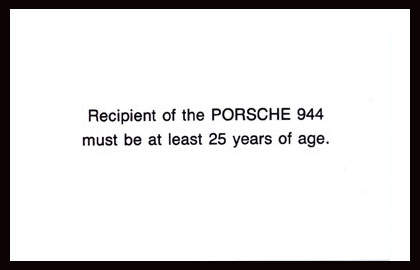 One pleasant incidental result of such requests was that we now have autographs from Norman McLaren, Michael Snow, Ernie Gehr, and Bruce Connor. These unfortunately are on dull request forms. Connor livened his up a bit by adding, “I own the splices on my films. The images from individual frames are not copyrighted by myself.” He also enclosed the accompanying card as a little surrealist gesture.
One pleasant incidental result of such requests was that we now have autographs from Norman McLaren, Michael Snow, Ernie Gehr, and Bruce Connor. These unfortunately are on dull request forms. Connor livened his up a bit by adding, “I own the splices on my films. The images from individual frames are not copyrighted by myself.” He also enclosed the accompanying card as a little surrealist gesture.
We never got in trouble with the copyright holders for reproducing the hundreds of frames in Film Art. Most of our other books have also involved frames, from Méliès shorts to The Lord of the Rings.
The 1993 Report on Fair Use and Film Stills
Initially some of our editors were a bit reluctant to include those frames unless we obtained permissions from the copyright holders, but we managed to talk them into it. Then, in the early 1990s, I was asked to chair a special committee of the Society for Cinema Studies (now the Society for Cinema and Media Studies) to investigate the question of fair use of film frames and photographs. The result was the “Report of the Ad Hoc Committee of the Society for Cinema Studies, ‘Fair Usage Publication of Film Stills,’” written by me with help from my colleagues John Belton, Dana Polan, and Bruce F. Kawin. Experts, including the Register of Copyrights, Ralph Oman, and Prof. Peter Jaszi, an expert on copyright law, contributed their thoughts on the matter. The report first appeared in the Winter 1993 issue of Cinema Journal and is available online.
The fair-use law itself is simple. Here are the factors to be considered in determining whether the reproduction of a work violates its copyright:
1) the purpose and character of the use, including whether such use is of a commercial nature or is for nonprofit educational purposes;
(2) the nature of the copyrighted work;
(3) the amount and substantiality of the portion used in relation to the copyrighted work as a whole; and
(4) the effect of the use upon the potential market for or value of the copyrighted work.
That last one seems to me particularly important for scholars, since it would be very difficult, if not impossible to prove that anything we publish diminishes the market value of the original. Quite the contrary, we help in our own small way to publicize that original.
I argued in the report that fair use did apply to film frames used in an educational context. The case for reproducing publicity and other behind-the-scenes photographs was considerably less clear, since unlike film frames, photographs can be individually copyrighted.
The report has had salubrious effects on film publications. Slowly more journal and academic-press editors accepted the idea that fair use does mean that authors don’t need to seek permissions. Given that most big studios either ignore such requests or demand hundreds or even thousands of dollars for their consent, the new policies of many journals and presses was a great boon to cinema studies. Gradually more and more scholarly and educational publications used frames instead of publicity stills, which made their descriptions and analysis much more effective. By now the use of film frames has become common practice.
Some encouraging cases
Occasionally, however, someone who is nervous about using frames writes to me to ask if anything has happened since 1993 that would change the situation. Has anyone been sued by a film studio for using film frames? Has a precedent been set?
In the report, I predicted that no studio would ever sue over the academic use of film frames. That was partly because the studios have bigger fish to fry, particularly the huge question of how to prevent film piracy. In contrast to bootleg DVDs selling for a couple of dollars in the streets of Shanghai or Moscow, we film scholars do not figure in the consciousness of the studio legal departments.
There have been some events that I think make it worth revisiting the issue of fair use in a more informal way here.
First, the very fact that the use of frame enlargements has become so common and that fewer academics seek permissions from copyright holders itself sets a precedent. As I said, it’s common practice now. I assume there probably are still editors who would rather be safe than sorry and demand that the author obtain permissions for illustrations. I assume there are probably some authors who abide by that decision or who are themselves worried about copyright and so do seek and even pay for unnecessary permissions. As always in discussing this issue, I urge editors and authors not to seek permissions, since it sets a different and dangerous precedent, implying that fair use might not apply in such publications.
Second, there have been some interesting court cases which don’t involve film frames but which do suggest that fair use applies to the sorts of images that film scholars might wish to employ.
In August of 2006, a decision came down in the case “Christopher R. Harris v. San Jose Mercury News.” (See here for an article on the case from Communications Lawyer.) Like many other newspapers, the Mercury News had used a photograph from a book in a review of that book. The newspaper cropped the photo, including eliminating the copyright notice. Harris, the photographer, sued for infringement.
The closing argument was presented by Gary Bostwick, of the major law firm Sheppard Mullin Richter & Hampton, which works in, among other areas, entertainment law and intellectual property rights law. An abridgement of Bostwick’s argument for the reproduction of the photo as fair use is included in the article linked above. The article concludes: “The jury deliberated for only thirty-seven minutes before concluding that copying photographs from books for use in reviews was fair use.”
If a newspaper review can reproduce photographs, surely a scholarly book could claim an even greater right to do so.
Recently I sat down with my friend and colleague, James Peterson, of Godfrey & Kahn, S.C., who practices intellectual property rights law here in Madison. James got his Ph.D. in film studies at the University of Wisconsin. His dissertation (the committee for which David co-chaired along with J. J. Murphy) was subsequently published as Dreams of Chaos, Visions of Order: Understanding the American Avant-Garde Cinema (Wayne State University Press, 1994). The book contains frame enlargements, obviously vital in any attempt to analyze experimental films. James’s expertise in film studies and his subsequent law degree make him particularly attuned to the needs of scholars in the field and the rights involved in using images in academic publications.
During our conversation, I mentioned that many books using frame enlargements had been published since the SCS report was published. James responded:
On the frame enlargements issue, to me, really, although there’s no case law verifying the old SCS analysis from twenty years ago, I think it’s right. I don’t have any reason to doubt it. Now, I have a personal commitment to it myself, because I relied on it when I did my book. Nothing in my experience as a lawyer has led me to think otherwise … I think the position on frame enlargements is much more secure than on production stills. Marginally more at least.
I mentioned that David and I had also used production stills in our books without seeking permission. James responded:
I would think that those are fair, too. To me the biggest case is the Bill Graham Archives case (the district court case in the letter) and that was affirmed right down the line by the second circuit court of appeals. So to me that’s a huge fair-use case for scholars.
The case James refers to is one he cited to me in a letter summing up his opinions on the fair-use status of various kinds of illustrations that I wanted to use in The Frodo Franchise. The second circuit court of appeals he refers to is in New York, and it often handles major cases involving copyright law.
The case in question was “Bill Graham Archives v. Dorling Kindersley Limited, Dorling Kindersley Publishing, and RR Donnelley & Sons Company.” At issue were some illustrations in a book, Grateful Dead: The Illustrated Trip. This was a coffee-table cultural history of the band, done with the members’ cooperation. The book reproduced without obtaining permission seven images on which the Bill Graham Archives claimed copyright. There had in fact been some negotiations between the publishers and the archive, but as a fee could not be agreed on, the illustrations were reproduced without permission. The copyrighted images had been “originally depicted on Grateful Dead event posters and tickets.”
The court decided in favor of the publishers, declaring the reproduction of the seven images constituted fair use and thus upholding the lower court’s decision. In summing up, the court declared (using the four factors determining fair use listed above):
On balance, we conclude, as the district court did, that the fair use factors weigh in favor of DK’s use. For the first factor, we conclude that DK’s use of concert posters and tickets as historical artifacts of Grateful Dead performances is transformatively different from the original expressive purpose of BGA’s copyrighted images. While the second factor favors BGA because of the creative nature of the images, its weight is limited because DK did not exploit the expressive value of the images. Although BGA’s images are copied in their entirety, the third factor does not weigh against fair use because the reduced size of the images is consistent with the author’s transformative purpose. Finally, we conclude that DK’s use does not harm the market for BGA’s sale of its copyrighted artwork, and we do not find market harm based on BGA’s hypothetical loss of license revenue from DK’s transformative market.
James expressed his opinion about the decision: “At least on the use of illustrative material, I think that case is very powerful.”
Powerful indeed, because it suggests that film scholars would be justified under fair use even if they reproduced whole production photos, posters, and other visual material directly related to the discussion in the text of their book or article, all without seeking permission.
I mentioned the widespread use of frame enlargements and photographs on the internet, particularly on fan websites. James gave his opinion on the use of photos on websites and then on our blog particularly:
The stock-photo houses are best positioned to complain about that activity, because they’re in the business of selling into that market. So if you want to illustrate something on your website, you shouldn’t just snatch it and stick it on the website.
You guys are, to my way of thinking–what you are doing is almost infringement-proof, because you’re unimpeachably scholarly and you’re writing about the things that you’re copying. It would be different if you were just using it to illustrate your website. I think a lot of the fan sites might fall into that category. They’re not connecting scholarship about the thing. They’re using the things they’re copying to attract attention to their own work. That, I think, is a different enterprise.
All of this is good news for cinema studies. So yes, things have happened since 1993 that would change the situation for film scholars, and it’s all for the better. Fair use is obviously alive and well, and those of us who need to reproduce the images we discuss can do so. Let’s all go analyze a film!
Note: Important policy statements on fair use in related areas have been released in the past few years. For the use of copyrighted material in documentary films, see the Center for Social Media’s “Documentary Filmmakers’ Statement of Best Practices in Fair Use” (2005) and its follow-up on the statement’s impact.
In 2007, the Society for Cinema and Media Studies released a statement targeted at classroom teaching: “The Society for Cinema and Media Studies’ Statement of Best Practices for Fair Use in Teaching for Film and Media Educators,” in Cinema Journal Volume 47, no. 2 (2008) or online.












